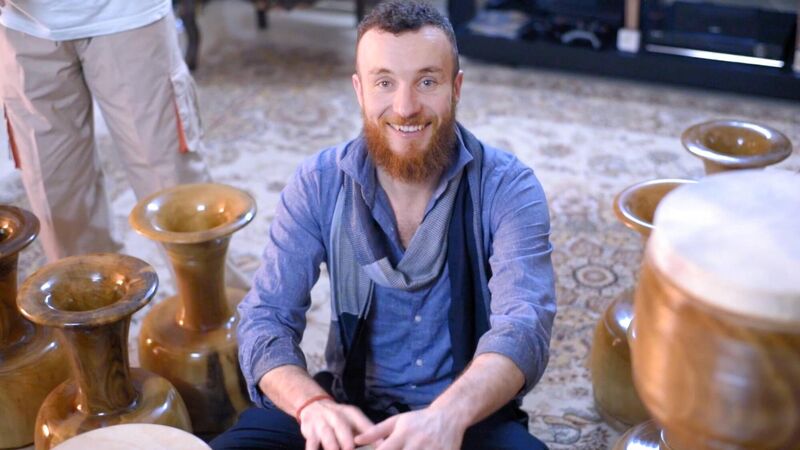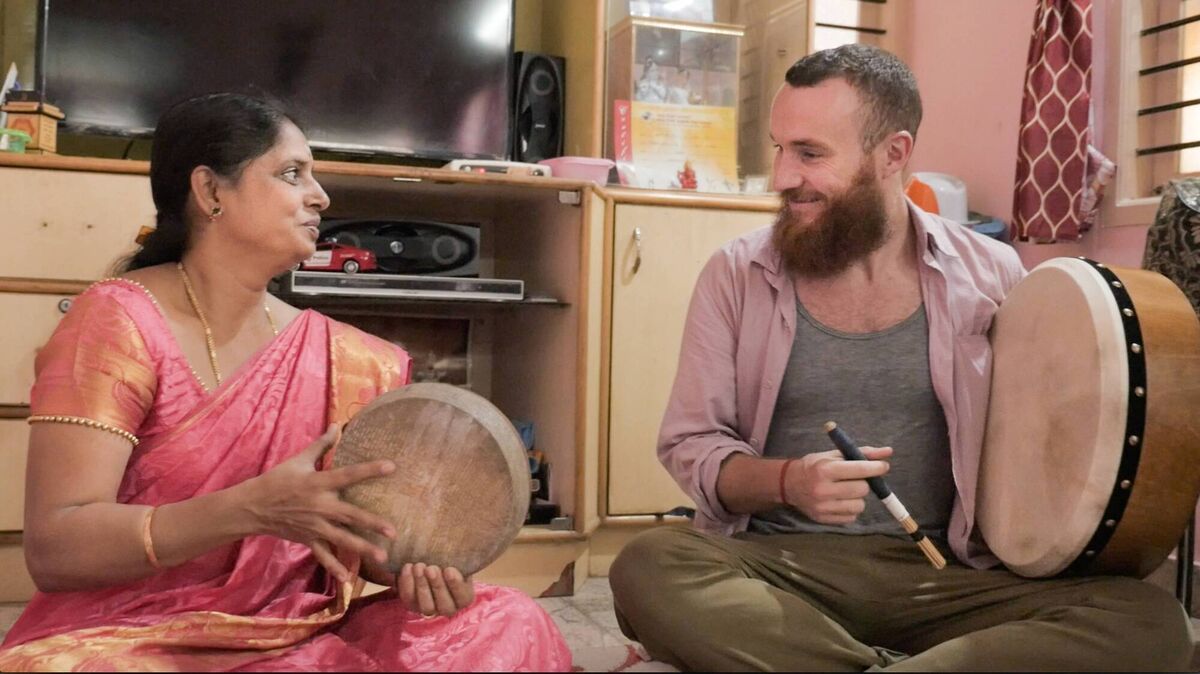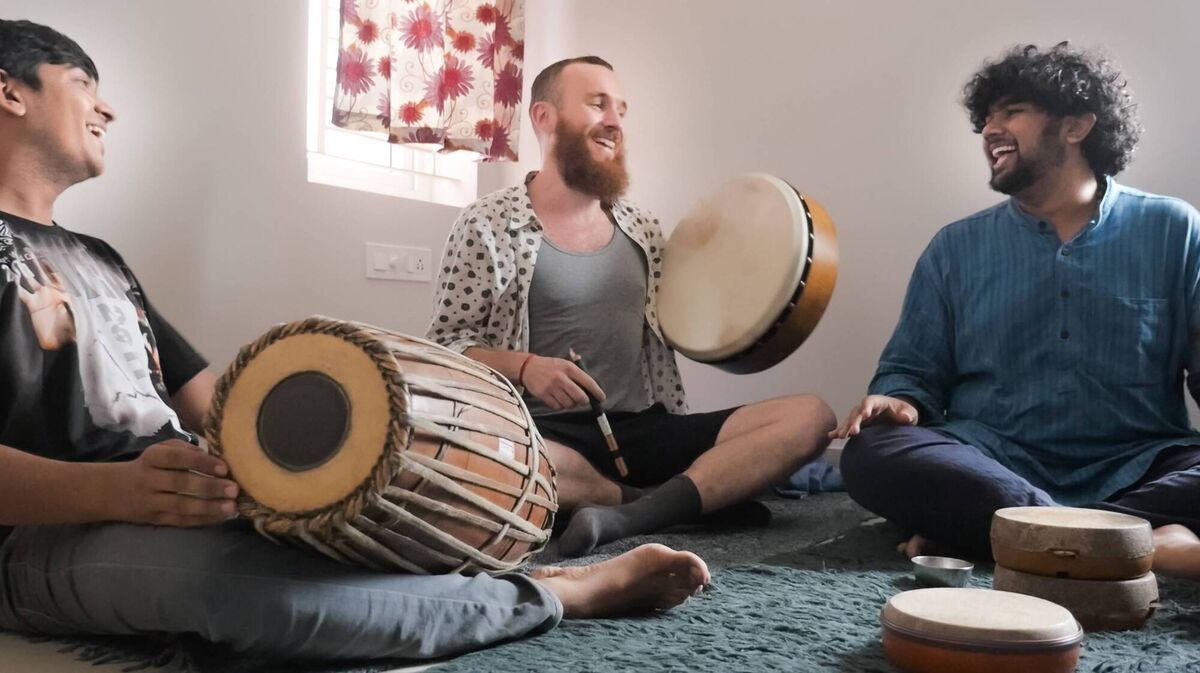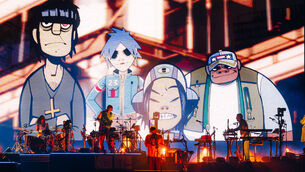Ruairi Glasheen: Tracing the rhythm of life from Cork to Karnataka

Cork percussionist Ruairi Glasheen.
“The moment somebody is born, their life starts with a basic rhythm of 72 BPM [beats per minute]. That’s the heartbeat. You walk, there’s a rhythm. You run, there’s a rhythm. You dance, there’s a rhythm.”
In India, where Cork bodhrán player Ruairi Glasheen is exploring the Carnatic drumming traditions of the southern states, Sachin Prakash puts into words a belief common to percussionists all over the globe: the conviction that rhythm underpins life and transcends differences in language and culture.
Prakash and his fellow drummers are part of a new generation keen to harness the power of social media to help keep their millennia-old drumming traditions alive.
The double-ended mridangam and the small hand-drum known as the kanjira both feature in Glasheen’s three-part documentary, Hidden Drummers of India. A separate 45-minute documentary, Hidden Drummers of Iran, explores Persian percussion.
Born in Cobh, Glasheen attended secondary school at Christian Brothers in Cork city, beginning his musical education in drums and orchestral percussion in Cork School of Music. He continued his education at the Royal College of Music in London, where he still lives today, combining teaching work with his folk group Tír Eolas.
Glasheen’s documentaries see him interview players, teachers and drum-makers, and also jam alongside his new-found counterparts on the bodhrán.
For Glasheen, who first picked up the bodhrán at just four years old, fitting in with other drumming traditions is second nature: “I’ve been playing for such a long time that it feels like a voice. It’s like that with a new drum, it’s like, we’ve never met before, but we can still have a conversation. I can kind of understand some bits of your music, and we can make that work.”

But in Bengaluru, the capital city of Karnataka, and in sweltering Chennai, six hours away on the coast, Glasheen encountered a problem he had not foreseen.
“In India it was so hot and so humid that the bodhrán skin needed to be tuned up constantly,” he says. “The guys would be like, ‘come on, let’s jam!’ and I’d be drenched and the drum would be drenched. But the jams sessions were always really, really fun. At the heart of it all, it’s about the people, and establishing a real connection.”
These jam sessions are a light touch, with the main focus of the documentaries being on the outstanding dedication and passion of an emerging generation of drummers determined to carry forward their traditional music.
Sometimes, the future of that music is anything but secure. In Chennai, Glasheen brings a Kanjira out onto the streets, asking young people if they know what it is. Most don’t.
“We’re lucky in Ireland that with the bodhrán, there are so many passionate makers and players,” Glasheen says. “There’s no real risk for the tradition at the moment. It’s just going to grow. But with Kanjira, there’s a smaller number keeping it alive, so it’s important we get it all documented.”
Glasheen travelled to India in the summers of 2018 and 2019: before this, he had travelled to Iran to film his documentary on Persian drumming, which was released on YouTube in January 2020.
Initially, he hoped his Iranian documentary would serve as a pilot episode and that a TV channel would be interested in commissioning a series. But in the end, following a handful of festival screenings and events, Glasheen decided to make his documentaries available for free to the public via YouTube.
“I’d pitched it to broadcasters and the feedback was positive, but it was like, ‘great idea, who are you?’” he says. “It was all very non-committal so I just decided we’d make a film regardless. And once I’d decided that, it was very liberating.
“The film was finished in 2019, but in January 2020, things were really tough in Iran: a plane was shot down and there was instability and protests. I was in touch with all my friends there. I thought, why am I sitting on this film which shows a different perspective, that’s not political? I put it on YouTube. It’s taken a longer time to build an audience, but anyone can access it any time and it’s there for anyone who’s open to watching it.”
Glasheen self-financed the travel to Iran for himself and filmmaker Yury Sharov and ran a kickstarter campaign to fund the post-production process.

In Iran, Glasheen focused on the Tonbak drum, and interviewed both veteran performers and younger musicians, including rising Tonbak star Javad Alirezaei.
Iran’s historic opposition to westernising influences and the oppressive and censorious regime that took root following the 1979 Iranian revolution, when the country became a conservative Islamic state under the Ayatollah Khomeini’s leadership, means it has remained an outsider nation, one which is often misunderstood by western countries.
“As westerners, growing up and watching documentaries, there’s this outside view on things,” Glasheen says. “I wanted to just be there for the journey, and to let people lead the narrative. We’re just the guys in the background, experiencing this incredible culture.”
In the Islamic Republic, music has been considered subversive and musicians could run the risk of censorship or persecution. But young players are using social media to reach a global audience and to preserve their traditions.
It’s a movement that Glasheen, with his own experience of independent digital media, can easily appreciate.
“I’m so inspired by them,” he says. “It’s incredible to me, that they’re part of an ancient tradition but that they’re still doing all the things that young people do.
“There’s a bed of restrictions that have been there for ages, but the world has moved on and people can communicate a lot more freely. Every now and then, someone goes over the line, but it’s just a matter of time until there is more freedom.”
The Hidden Drummers of Iran and The Hidden Drummers of India are available to watch on Ruairi Glasheen’s YouTube channel.
Kanjira: A frame drum that looks a little like a tambourine with only one zill, the kanjira is a small drum played with the fingers.
Mridangam: A large double-ended drum made from jackfruit wood and goatskin, capable of producing both bass and treble sounds.
Ghatam: A clay pot designed specifically to be played as a drum, the ghatam is one of India’s most ancient percussion instruments. It is played with the fingers and the palms of the hands and can produce a wide variety of different tones.
Tonbak: The onomatopoeic Tonbak, featured in Ruairi Glasheen’s Iranian documentary, is named for the two tones it can produce, the bassy “ton” and the higher, flatter “bak” sound.
Daf: An ancient frame drum that predates the arrival of Islam in Iran, the daf is used widely not only in Iranian music but also in Kurdish and Pakistani traditions. Large and flat, it has a collar of metal rings underneath the drum skin; playing the daf involves a combination of shaking and throwing the drum with hitting the surface with the fingers.





